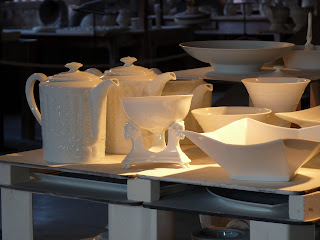 Just as depicted on this plate, the Manufacture Bernardaud stands today in Limoges with studio shelves copiously and ever so carefully filled with thousands of unfired examples of its treasures. This location operated fully until 1991 when the factory set off for modern premises just outside the city. Still in partial use as a work place, today it can be toured with a guide and demonstrations of the porcelain making process.
Just as depicted on this plate, the Manufacture Bernardaud stands today in Limoges with studio shelves copiously and ever so carefully filled with thousands of unfired examples of its treasures. This location operated fully until 1991 when the factory set off for modern premises just outside the city. Still in partial use as a work place, today it can be toured with a guide and demonstrations of the porcelain making process.The Chinese were able to keep the ancient secret of their fabulous art of porcelain making until the 18 th century. Before this, these sophisticated products were known only to royalty and certain aristocratic European collectors who admired them for their beautiful translucent quality and fineness, as well as for their strength and impermeability. What a contrast with other opaque ceramics or fragile soft-paste porcelain made in Europe at this time ! Desire for exotic Oriental porcelain had reached fever pitch in the Occident in the late 17 th century and continued well into the 18 th. Experimenters in Europe had long been trying to equal Chinese products. This had already been accomplished in Saxe in 1708. The competition was on. Finally in 1767, the wife of a surgeon in Limoges found a particular clay that worked very well to launder her linens. Thinking it a sort of natural soap, she showed her discovery to her husband, who in turn showed it to an apothecary. Analysis proved this special clay to be kaolin, one of three ingredients along with feldspar and quartz, necessary for producing hard-paste porcelain. Limoges would now achieve world-renown for its porcelain artistry.




There is something beautiful about all these white molds and raw pieces. They have a mat glow, but careful this is not bisque -- fragile !

Handles and spouts are cast separately by pouring slip or liquid paste into special molds. These items are then attached to the body of an object with with brush applied slip -- never with glue.
 Each piece is fired at least twice. One 24 hour passage in the kiln strengthens and makes the piece porous. This is bisque firing. After the piece has been dipped into glaze to make it impermeable, next comes a second, extremely high temperature firing. The final tureen at right shows a shrinkage of 14%.
Each piece is fired at least twice. One 24 hour passage in the kiln strengthens and makes the piece porous. This is bisque firing. After the piece has been dipped into glaze to make it impermeable, next comes a second, extremely high temperature firing. The final tureen at right shows a shrinkage of 14%.
These vessels have been fired twice and may or may not be decorated and fired again. They can now be tested for any imperfections with the flick of a finger. A perfect piece will have the characteristic ring of porcelain. Notice the Louvre pattern teapot and The Marie-Antoinette Laiterie coupe.
More finished examples to come !

Interesting post. Thanks for all the great photos!
ReplyDeleteHope you'll like the finished pieces too. I'll have other porcelain items to show but two posts are enough for now!
ReplyDelete